| Columns Retired Columns & Blogs |
Genesis Advanced Technologies 5.2 loudspeaker Measurements
Sidebar 3: Measurements
I estimated the Genesis 5.2's voltage sensitivity as 89.2dB/2.83V/m, which is within experimental error of the specified 90dB figure. However, as can be seen from the plot of its impedance magnitude and phase (fig.1), the speaker demands a lot of current from the partnering amplifier. With the tone controls set to their maximum positions (bottom trace), the impedance drops below 2 ohms for most of the lower midrange and briefly in the mid-treble, where the minimum impedance is a low 1.4 ohms at 7.8kHz. More problematic, the phase angle is highly capacitive in the bass, due to the crossover to the powered woofer section, which will exacerbate the already low impedance. At 112Hz, for example, a frequency where music has considerable energy, an impedance of 3.3 ohms is combined with an electrical phase angle of –62°, which will suck an enormous amount of current from the amplifier. Similarly, a magnitude of just 2.5 ohms at 1kHz, again a frequency where music has much energy, is coupled with a phase angle of +35°. Solid-state Mark Levinsons, Krells, Classés, and the like should be used with this speaker. Tube amplifiers are best avoided unless they have a hefty 2 ohm–rated output transformer.
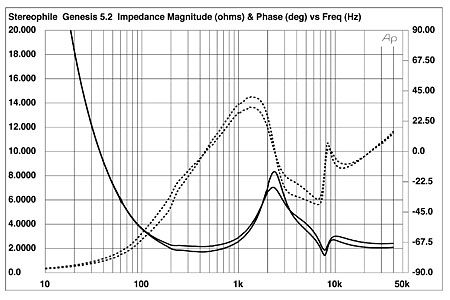
Fig.1 Genesis 5.2, electrical impedance (solid) and phase (dashed) with midrange and treble controls in maximum and minimum positions (2 ohms/vertical div.)
The 5.2's woofer enclosure was basically inert; I could find no significant resonant modes. The sidewalls of the midrange/tweeter enclosure had some modes apparent between 250Hz and 350Hz, but these were not high enough in level to introduce colorations. Fig.2 shows the nearfield response of the woofers with the crossover low-pass filter set to positions ranging from 135Hz to 71Hz. The woofers basically cover the range from 20Hz at the low end to 100–200Hz (–6dB points), depending on the low-pass filter setting. The black trace is the 90Hz response, which is the manufacturer-recommended default setting, and is repeated on the left-hand side of fig.3. The actual crossover point between the lower-midrange units and the powered woofers is approximately 120Hz, though this can be fine-tuned with the woofer level and low-pass controls.
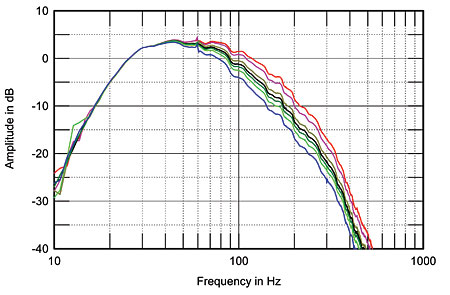
Fig.2 Genesis 5.2, nearfield woofer response with low-pass filter set to 135Hz (red), 114Hz (magenta), 97Hz (yellow), 90Hz (black), 84Hz (dark green), 79Hz (light green), and 71Hz (blue).
To the right of fig.3 is shown the 5.2's farfield response on the tweeter axis, averaged across a 30° horizontal window, spliced to the sum of the front upper and lower midrange units below 300Hz. (The midrange and tweeter rotary controls were set to their middle positions for this measurement.) The speaker's frequency balance is relatively uniform in the treble, with a slow rolloff apparent above 10kHz, mainly due to the tweeter's limited dispersion in this region. The Genesis' behavior in the midrange is complex, with a peak apparent between 500Hz and 700Hz and a lack of energy in the lower midrange. In-room, however, the speaker's rear-facing midrange coupler and the dipole behavior of the upper-midrange unit will modify this quasi-anechoic response (see later).
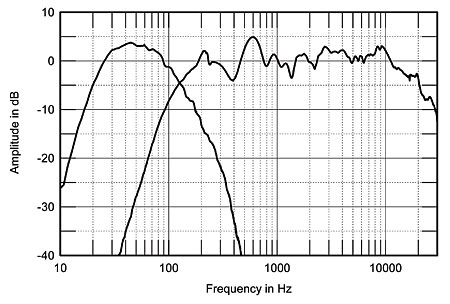
Fig.3 Genesis 5.2, anechoic response on tweeter axis at 50", averaged across 30° horizontal window and corrected for microphone response, with the summed nearfield responses of the midrange units below 300Hz, and the nearfield response of the woofers with the low-pass filter set to 90Hz.
Fig.4 shows the effect of the tone controls on the response shown in fig.3 (just the differences are plotted in this graph). The Tweeter control (red traces) provides ±2dB of boost/cut above 5kHz. While the Midrange control (blue traces) provides approximately ±1.5dB of adjustment below 1kHz, it also has an effect on the front tweeter's output above 8kHz or so. Fig.5 shows the 5.2's vertical dispersion, referenced to the response on the tweeter-axis, which is 40" above the floor. Sitting below that axis pulls down the mid-treble a little, but otherwise the Genesis' balance is relatively uncritical of listening height except at extreme off-axis angles.
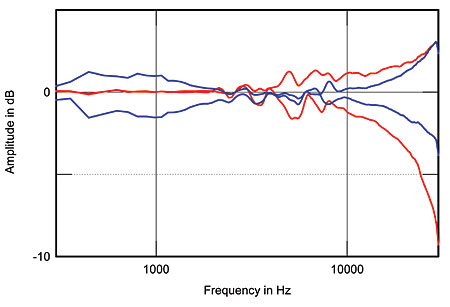
Fig.4 Genesis 5.2, effect on the tweeter-axis response of the midrange control (blue) and treble control (red) set to their maximum and minimum positions (5dB/vertical div.).
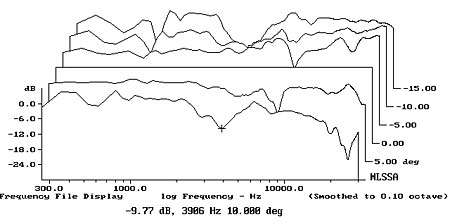
Fig.5 Genesis 5.2, vertical response family at 50", normalized to response on tweeter axis, from back to front: differences in response 15–5° above axis, reference response, differences in response 5–10° below axis.
The Genesis 5.2's lateral dispersion, normalized to the tweeter-axis response with the tone controls centered, is shown in fig.6. The radiation pattern is generally wide and even in the treble, other than at extreme off-axis angle, where some dipole cancellation occurs with the open-back upper-midrange unit and the opposite-phase, rear-facing tweeter. The dispersion is complex in the lower midrange, again due to the combination of front- and rear-firing midrange units and the dipolar upper-midrange unit. However, it looks as if the lack of lower-midrange energy on the on-axis response fills in to the speaker's sides, with a notch developing at the frequency of the on-axis peak.
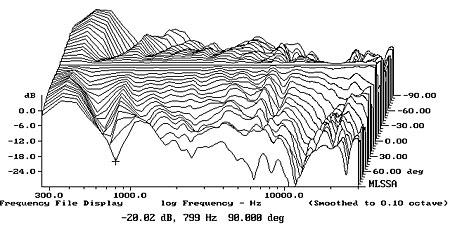
Fig.6 Genesis 5.2, lateral response family at 50", normalized to response on tweeter axis, from back to front: differences in response 90–5° off axis, reference response, differences in response 5–90° off axis.
The proof of any design is in the listening room, of course, and fig.7 shows the Genesis 5.2's response measured in my room, averaging 120 1/3-octave responses taken for left and right speakers individually in a grid centered on the position of my ears. (The Midrange and Tweeter controls were at their maximum settings for this measurement.) There is still a small excess of energy apparent between 500Hz and 800Hz, but the lower midrange is almost up to the 1kHz reference level. The woofer low-pass filter was set to the factory-recommended 90Hz, but I set the woofer level by ear. You can see that I like bass—with the usual amount of low-frequency room gain, I ended up with the woofers 2–3dB too high in level. Higher in frequency, the Genesis 5.2 produced a fairly flat in-room response.
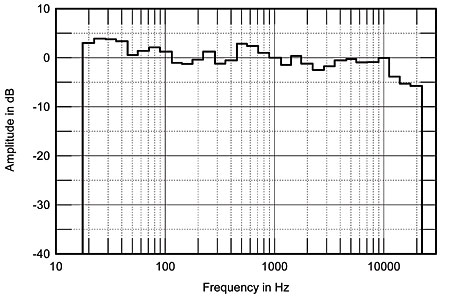
Fig.7 Genesis 5.2, spatially averaged, 1/3-octave response in JA's listening room, tone controls set to maximum, woofer low-pass filter set to 90Hz, woofer level set by ear.
Turning to the time domain, the red trace in fig.8 shows the 5.2's step response on the front tweeter's axis. All the drive-units are connected in positive acoustic polarity, with the tweeter's output slightly ahead of that of the midrange units, which in turn are quite a bit ahead of the woofers' output. The blue trace in fig.8 is the speaker's step response taken on the axis of the rear-facing tweeter. It is hard to interpret, but what you see, in conjunction with the nearfield step responses, is the slow-rising, negative-polarity output of the rear-facing lower-midrange unit, over which is laid the negative-polarity steps of first the rear tweeter, then the rear of the front upper-midrange unit, which is open at its rear. This actually overlays the slow, positive-polarity step of the single rear-facing woofer.
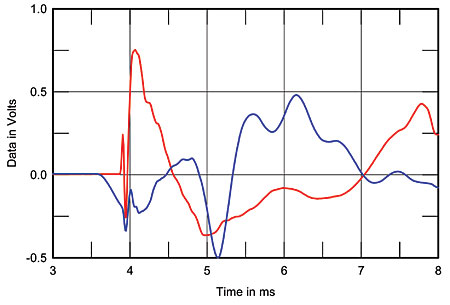
Fig.8 Genesis 5.2, step responses on tweeter axis at 50" (red) and on rear tweeter axis (blue). (5ms time window, 30kHz bandwidth.)
Fig.9 shows the Genesis' cumulative spectral-decay plot on the tweeter axis. The complicated interaction of the front- and rear-firing drive-units gives rise to some ridges of delayed energy in the midrange. The treble is clean, though a resonance is apparent at 8.2kHz, coinciding with a small peak in the frequency response at the same frequency.
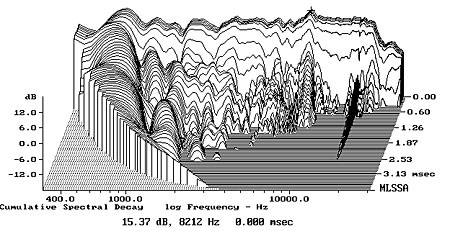
Fig.9 Genesis 5.2, cumulative spectral-decay plot at 50" (0.15ms risetime).
Finally, I examined the generation of wolf tones mentioned in the "Sound quality" section by driving one of the speakers with a signal generator and varying frequency and drive level until I excited the behavior. Fig.10 shows the spectrum of the speaker's output with a 3.5kHz sinewave at a level of 87dB at 1m. The spectral line peaking at –5dB is the 3.5kHz tone, and harmonics can be seen at 7kHz (–29dB), 10.5kHz (–25dB), 14kHz (–36dB), and 17.5kHz (–42dB), all levels referenced to the fundamental. The circular ribbon tweeter is not very linear at this level at the bottom of its passband; the presence of these harmonics is why I found the pure tone to sound metallic in this region. However, a spectral line can be seen at half the frequency of the fundamental, 1.75kHz. Admittedly, the level of this subharmonic is lower than the harmonics, –45dB, but I found it very audible because of the lack of masking.
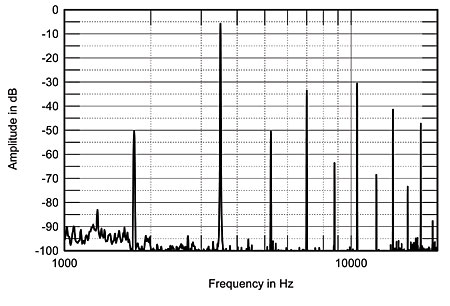
Fig.10 Genesis 5.2, spectrum of 3.5kHz tone at 87dB SPL at 1m on tweeter axis (5dB/vertical div.).
The mathematician Manfred Schröder has suggested that the presence of subharmonics is an indication of chaotic behavior in a diaphragm. I have found similar behavior in large panels. As I said in my auditioning, I didn't find this peculiar behavior to be a limiting factor with music, but it does suggest that the Genesis 5.2's ultimate dynamic range will be limited more by the tweeter than by any other factor.—John Atkinson
- Log in or register to post comments




































